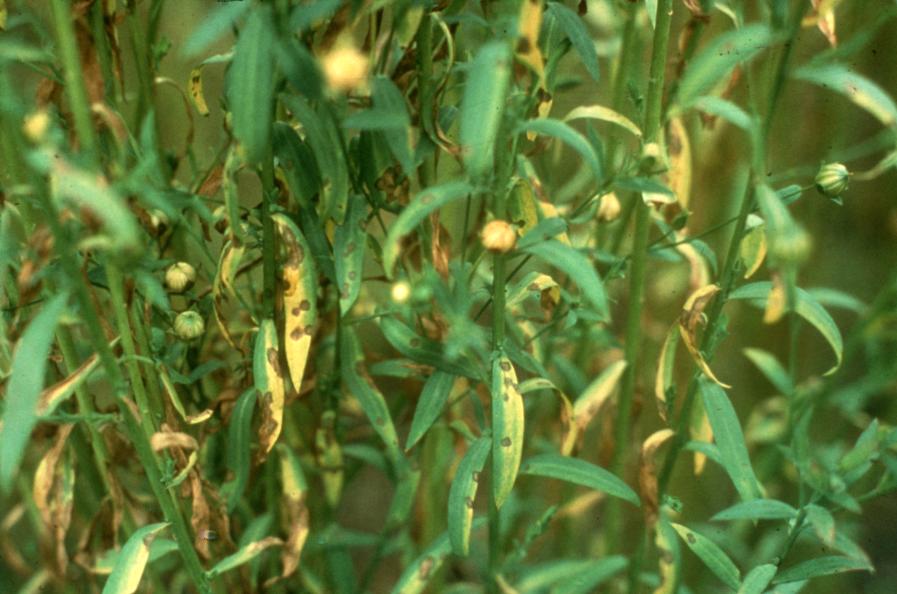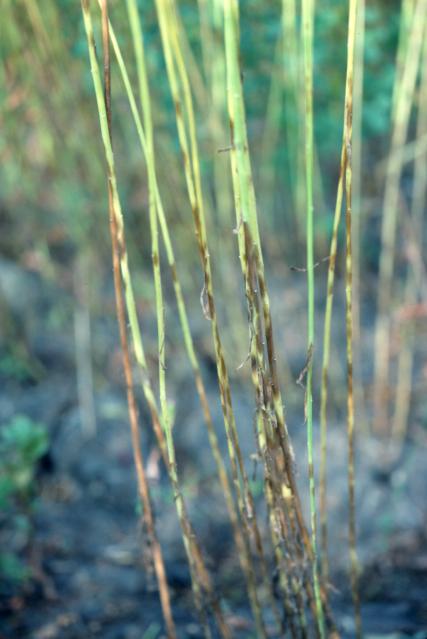Pasmo Disease Management in Flax
Author: Dr. Khalid Rashid, Agriculture and Agri-Food Canada, Morden, MB
Small dark brown to black lesions on leaves indicate pasmo infection on flax
The Disease: Pasmo is caused by the fungus Septoria linicola which is widespread globally, including throughout the flax growing areas of Western Canada. Pasmo has been observed in all flax fields surveyed in Western Canada, with disease severity ranging from traces to 60% of the foliage affected. Yield losses in infected fields have ranged from 10-30%.
Life Cycle: Inoculum survives the winter on flax stubble. With rain and warmer weather of spring, fungus spores ooze out of the pycnidia fruiting bodies on the flax stubble and are splashed by rain droplets to flax seedlings. Fresh pycnidia and spores are produced on the infected lesions and are spread again by rain splash. Pasmo may complete multiple life cycles within a flax field.
Symptoms and Crop Damage: The initial symptoms of pasmo are small dark brown to black lesions (spots) on the lower leaves of flax plants. Symptoms may appear on flax leaves from the seedling stage to maturity. Splashing rain and wind spread the infection to flax leaves and stems vertically and horizontally to adjacent plants. Dark brown to black bands of pasmo infection start showing up on flax stems shortly after flowering and this weakens the stems. Pasmo results in defoliation and weakening of the stems resulting in stem breakage and lodging. The overall impact is lower yield (10-30%) and quality of the harvested seed and stem fibre.
Pasmo dark brown to black bands on flax stems
To Spray or Not to Spray (with foliar applied fungicides):
- The best time to determine if your need to spray for pasmo is early flowering
- At this stage, look for dark brown to black lesions on the lower leaves of flax plants
- If lesions are observed, apply fungicide at early flowering for best control. Currently, only Headline EC and Priaxor fungicides are registered for pasmo control in flax. Further information on these fungicides is described in your provincial Crop Protection Guides.
- Re-check your fields 1-2 weeks after the first application, especially if they have received frequent rain showers and warm weather during flowering. If lesions are observed on new growth, consider applying fungicide a second time.
- Field research has shown that several fungicides reduce pasmo by 30-60% and improve yield by 15-25%
TIPS to Manage Pasmo:
- A minimum of three years of crop rotation (reduce overall inoculum in field)
- Avoid adjacent fields of flax (avoid disease spread from field with flax stubble to new seedlings)
- Plant lodge resistant varieties (lodged plants result in wetter microclimate for disease spread)
- Use recommended seeding rate (very high seeding rates increase probability of lodging)
- Control weeds (thick canopy of crop and weeds favour wet microclimate for disease development)
- -There are no registered flax varieties with resistance to pasmo
Other Considerations: Pasmo often results in premature flax harvests. Application of fungicides to control pasmo may result in normal days to harvest (up to 7-10 days later to mature than pasmo infected field). Earlier seeding may be beneficial if you farm in an area that frequently requires pasmo control.
Concrete efforts are underway to find sources of genetic resistance to incorporate in future flax cultivars. Manufacturers, distributors and government regulating agencies are also endeavouring to register additional fungicides for pasmo control; either through full registration or the minor use registration process.





